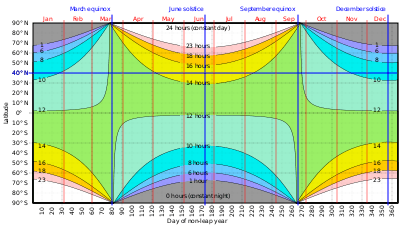Sunrise equation

The sunrise equation as follows can be used to derive the time of sunrise and sunset for any solar declination and latitude in terms of local solar time when sunrise and sunset actually occur:
where:
- is the hour angle at either sunrise (when negative value is taken) or sunset (when positive value is taken);
- is the latitude of the observer on the Earth;
- is the sun declination.
Theory of the equation
The Earth rotates at an angular velocity of 15°/hour. Therefore, the expression gives the interval of time before and after local solar noon that sunrise or sunset will occur.
The sign convention is typically that the observer latitude is 0 at the equator, positive for the Northern Hemisphere and negative for the Southern Hemisphere, and the solar declination is 0 at the vernal and autumnal equinoxes when the sun is exactly above the equator, positive during the Northern Hemisphere summer and negative during the Northern Hemisphere winter.
The expression above is always applicable for latitudes between the Arctic Circle and Antarctic Circle. North of the Arctic Circle or south of the Antarctic Circle, there is at least one day of the year with no sunrise or sunset. Formally, there is a sunrise or sunset when during the Northern Hemisphere summer, and when during the Northern Hemisphere winter. Out of these latitudes, it is either 24-hour daytime or 24-hour nighttime.
Generalized equation
Also note that the above equation neglects the influence of atmospheric refraction (which lifts the solar disc by approximately 0.6° when it is on the horizon) and the non-zero angle subtended by the solar disc (about 0.5°). The times of the rising and the setting of the upper solar limb as given in astronomical almanacs correct for this by using the more general equation
with the altitude (a) of the center of the solar disc set to about −0.83° (or −50 arcminutes).
Complete calculation on Earth
The generalized equation relies on a number of other variables which need to be calculated before it can itself be calculated. These equations have the solar-earth constants substituted with angular constants expressed in degrees.
Calculate current Julian day
where:
- is the number of days since Jan 1st, 2000 12:00.
- is the Julian date;
- 2451545.0 is the equivalent Julian year of Julian days for 2000, 1, 1.5.
- 0.0008 is the fractional Julian Day for leap seconds and terrestrial time.
- currently = 68.184 / 86400 without DUT1.
Mean solar noon
where:
- is an approximation of mean solar time at expressed as a Julian day with the day fraction.
- is the longitude west (west is negative, east is positive) of the observer on the Earth;
Solar mean anomaly
where:
- M is the solar mean anomaly used in a few of next equations.
Equation of the center
where:
- C is the Equation of the center value needed to calculate lambda (see next equation).
- 1.9148 is the coefficient of the Equation of the Center for the planet the observer is on (in this case, Earth)
Ecliptic longitude
where:
- λ is the ecliptic longitude.
- 102.9372 is a value for the argument of perihelion.
Solar transit
where:
- Jtransit is the Julian date for the local true solar transit (or solar noon).
- 2451545.5 is midnight or the beginning of the equivalent Julian year reference.
- is a simplified version of the equation of time. The coefficients are fractional day minutes.
Declination of the Sun
where:
- is the declination of the sun.
- 23.44° is Earth's maximum axial tilt toward the sun [1]
Hour angle
This is the equation from above with corrections for astronomical refraction and solar disc diameter.
where:
- ωo is the hour angle from the observer's zenith;
- is the north latitude of the observer (north is positive, south is negative) on the Earth.
For observations on a sea horizon an elevation-of-observer correction, add , or to the −0.83° in the numerator's sine term. This corrects for both apparent dip and terrestrial refraction. For example, for an observer at 10,000 feet, add (−115°/60°) or about −1.92° to −0.83°.
Calculate sunrise and sunset
where:
- Jset is the actual Julian date of sunset;
- Jrise is the actual Julian date of sunrise.
See also
References
External links
- Sunrise, sunset, or sun position for any location – U.S. only
- Sunrise, sunset and day length for any location – Worldwide
- Rise/Set/Transit/Twilight Data – U.S. only
- Astronomical Information Center
- Converting Between Julian Dates and Gregorian Calendar Dates
- Approximate Solar Coordinates
- Algorithms for Computing Astronomical Phenomena
- Astronomy Answers: Position of the Sun
- A Simple Expression for the Equation of Time
- The Equation of Time
- Equation of Time
- Long-Term Almanac for Sun, Moon, and Polaris V1.11